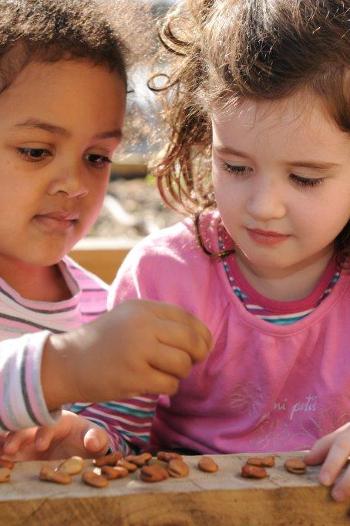Collecting and saving seeds
Duration/age

There are many different ways to grow more plants. They can grow from cuttings, seeds, seedlings, bulbs or rootstock.
Next time you do your fruit and vegetable shopping with your child see if you can predict which ones will have seeds inside. If they have seeds inside you could try and grow them.
I think the pumpkin will have seeds inside that we can try to grow.
A pumpkin has lots of seeds inside but the avocado only has one big seed.
Once you have collected the seeds from your shopping adventure talk to your child about what you need to do next. Can you plant them straight into the ground? Do you need to wait until the weather changes?
Pumpkins are planted in summer but the fruit is not ready to eat until winter. We have to collect, dry and store the seeds until summer.
Avocados can be planted any time of the year and will grow into a tree.
Talk to your child about what you need to do when the seeds can’t be planted straightaway. How do you store them? Do they need to be washed and dried?
This pumpkin has lots of seeds inside. There are more seeds than we need. We could share them with Nana and Papa. We can put 5 seeds in each paper bag and write ‘to plant in summer’ on the front.
If we don’t let the seeds dry out before we put them in a bag they will go mouldy and rot.
Materials you will need
- Envelopes
- Paper bag
- Fruit and vegetables
- Flowering plants
Skills this activity improves
Why does this matter?
When you and your child explore which fruit and vegetables have seeds you will be using prediction and comparative language. When you compare how they grow or talk about the amount of seeds inside, you are using number and size to make decisions. Number, size and quantity are forms of measurement.
Researching when different plants get planted and when they fruit helps your child to develop planning and sequencing skills. They will be using time and temperature to help make decisions about when something should happen.
Your child will be developing rich oral language to describe what they are doing, to compare one plant to another and to explain the growing cycle of the plant.
What does this lead to?
As your child begins to make decisions about what to grow and when to plant the seed they are developing the skills to make decisions based on data.
When you talk about how many seeds are inside and how many you want to plant, your child is learning about number and division. As you talk about how many seeds to put inside a packet or how many you need for planting, your child is learning that quantities can be divided into smaller amounts.
Language to use
- Plant, fruit, vegetable, flower
- Seed, seedling, bulb, cutting, rootstock
- Season, weather, time of year, calendar
- Seasonal, annual, perennial
Questions to use
- Do all plants have seeds?
- Do all plants grow from seeds?
- Does it matter when you plant a seed?
- What do seeds need to grow?
- How many plants grow from a single seed?
- Why does some fruit have lots of seeds?
Useful tips
- The Kitchen Gardens initiative has information about saving, growing and sowing seeds.
- The ABC has a regional growing guide that can tell you what to plant and when.
- You might also like to take a look at the activities Planting a garden you can eat and Growing wheat sprouts.
- Remember to talk to your child in your home language.
More ideas
- Grow sprouts and seeds on cottonwool.
- Make a sprout caterpillar using wheat, a stocking and potting mix.
Variation by age
Three to five year olds
- Go on a seed hunt around your garden and neighbourhood.
- Make a chart of different fruit and vegetables to show which ones have seeds and which ones don’t.
- Borrow books and stories from the library about growing plants.
- Design and make labels for your seed collection bags.
- Collect your own seeds and give them away as presents.


